
Horseshoe bats are bats in the family Rhinolophidae. In addition to the single living genus, Rhinolophus, which has about 106 species, the extinct genus Palaeonycteris has been recognized. Horseshoe bats are closely related to the Old World leaf-nosed bats, family Hipposideridae, which have sometimes been included in Rhinolophidae. The horseshoe bats are divided into six subgenera and many species groups. The most recent common ancestor of all horseshoe bats lived 34–40 million years ago, though it is unclear where the geographic roots of the family are, and attempts to determine its biogeography have been indecisive. Their taxonomy is complex, as genetic evidence shows the likely existence of many cryptic species, as well as species recognized as distinct that may have little genetic divergence from previously recognized taxa. They are found in the Old World, mostly in tropical or subtropical areas, including Africa, Asia, Europe, and Oceania.

The lesser horseshoe bat is a type of small European and North African insectivorous bat, related to its larger cousin, the greater horseshoe bat. As with all horseshoe bats, the species gets its name from its distinctive horseshoe-shaped noseleaf.

The lesser woolly horseshoe bat, also called Beddome's horseshoe bat, is a species of bat in the family Rhinolophidae. It is found in India and Sri Lanka. Its natural habitats are subtropical or tropical moist lowland forests, caves, and urban areas.

The Cape horseshoe bat is a species of bat in the family Rhinolophidae. It is endemic to South Africa, and is potentially threatened by habitat loss and disturbance of its roosting sites, although it is present in large enough numbers to be considered of least concern by the IUCN.
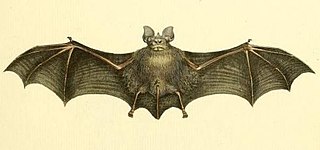
Geoffroy's horseshoe bat is a species of bat in the family Rhinolophidae found in Africa. Its natural habitats are subtropical or tropical moist lowland forest, Mediterranean-type shrubby vegetation, caves and other subterranean habitats, and hot deserts.

The Andaman horseshoe bat is a species of bat in the family Rhinolophidae. It is endemic to the Andaman Islands. During the day, it roosts in caves, but may also choose tree hollows.

Decken's horseshoe bat is a species of horseshoe bat. It is found in Kenya and Tanzania. Its natural habitats are tropica and subtropical moist lowland and montane forest, moist savanna, caves and other subterranean habitats.
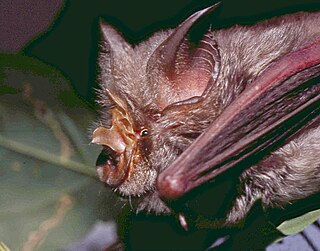
Rüppell's horseshoe bat is a species of bat in the family Rhinolophidae found in Africa. Its natural habitats are subtropical or tropical dry forests, savanna, caves and other subterranean habitats. This species is quite common in parts of its range, and no specific threats have been recognised, so the International Union for Conservation of Nature has rated its conservation status as being of "least concern".

Hildebrandt's horseshoe bat is a species of bat in the family Rhinolophidae found in Africa. Its natural habitats are savanna, caves and other subterranean habitats.
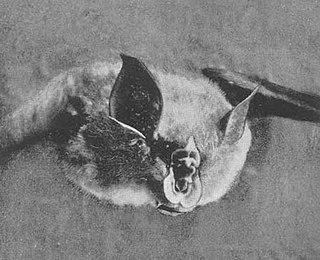
Lander's horseshoe bat is a species of bat in the family Rhinolophidae found in Africa. Its natural habitats are savanna and caves.

Blyth's horseshoe bat is a species of bat in the family Rhinolophidae. It is found across southern Asia from Afghanistan to Vietnam. The species can be identified from its pointed, bifid sella.

The smaller horseshoe bat is a species of bat in the family Rhinolophidae. It is found in Australia and Papua New Guinea.
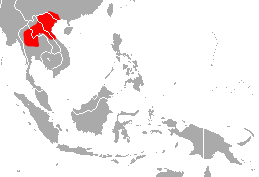
Bourret's horseshoe bat is a species of horseshoe bat native to Southeast Asia. The name "paradoxolophus" is derived from the Greek words paradoxos, meaning "contrary to expectation", and lophos, meaning "crest". This name refers to the bat's difference in nose-leaf morphology compared to other Rhinolophus species. There are no recognised subspecies.
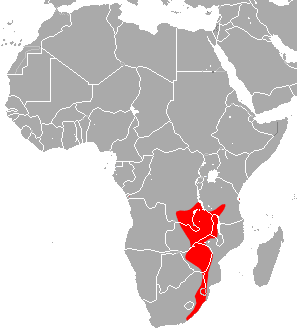
Swinny's horseshoe bat is a species of bat in the family Rhinolophidae. In English, R. swinnyi is commonly referred to as Swinny's horseshoe bat. In Afrikaans, it is commonly referred to as Swinny se saalneusvlermuis. This species belongs to the African clade. R. swinnyi was discovered by an African collector H. H. Swinny. They have been recorded in Angola, Republic of the Congo, Mozambique, South Africa, Tanzania, Zambia, Zimbabwe, and Malawi.
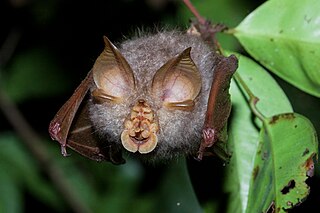
The trefoil horseshoe bat is a species of bat in the family Rhinolophidae. It is found in Brunei, India, Indonesia, Malaysia, Myanmar, Singapore, and Thailand. In Borneo locally common up to 1,800m, including mangroves.
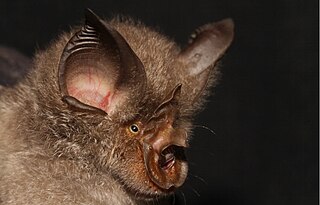
Smithers's horseshoe bat is a species of horseshoe bat found in South Africa and Zimbabwe. It was described as a new species in 2012.
The Damara horseshoe bat, is a species of bat found in Africa.
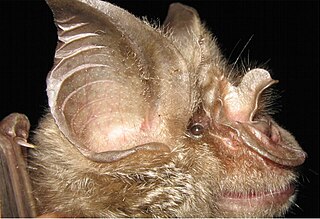
The Mozambican horseshoe bat is a species of horseshoe bat found in Africa.
The Mount Mabu horseshoe bat is a species of horseshoe bat that is endemic to the Southeast African nation of Mozambique.
















